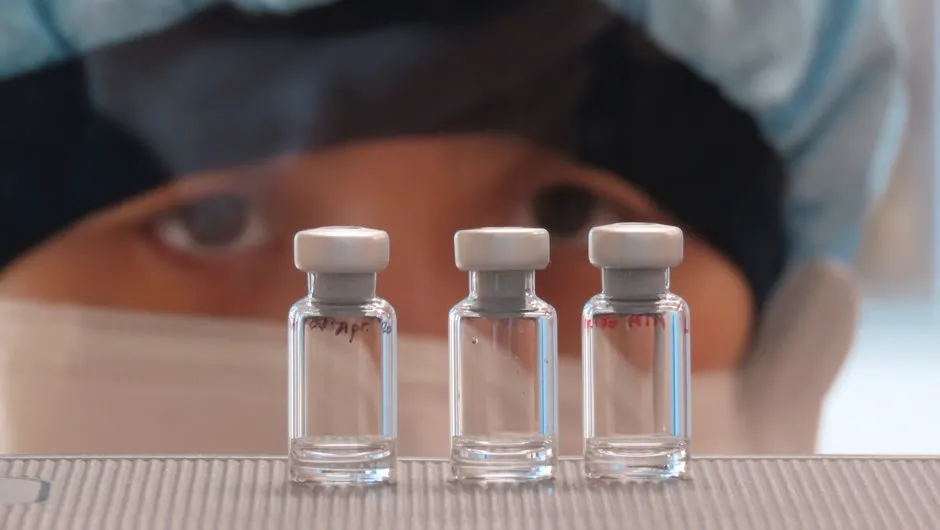Human trials of a potential coronavirus vaccine being developed by scientists in Oxford are reported to have shown promising results.
The researchers believe they have made a breakthrough after discovering the jab could provide “double protection” against the virus, the Daily Telegraph reported.
The newspaper said the phase 1 trial in healthy adult volunteers, which began in April, showed the vaccine generated an immune response, with blood samples indicating it stimulated the body to produce both antibodies and “killer T-cells”.
It came as Health Secretary Matt Hancock said teams were working towards a “best-case scenario” of a vaccine being made available some time this year, although he conceded it was more likely in 2021.
Read more about the coronavirus vaccine:
- COVID-19 vaccine ready in first half of 2021 if trials go 'really well'
- Coronavirus: manufacturing begins on 'millions of doses' of the Oxford vaccine candidate
- New method protects vaccines from heat degradation
David Carpenter, chairman of the Berkshire Research Ethics Committee, which approved the Oxford trial and continues to work with scientists on amendments, told the Telegraph that the team were “absolutely on track”.
“They can strengthen findings by targeting people in hospitals, healthcare professionals, where the spread is [more] likely to happen,” he said.
“Nobody can put final dates… things might go wrong but the reality is that by working with a big pharma company, that vaccine could be fairly widely available around September and that is the sort of target they are working on.”

But a source told the newspaper that the results did not yet prove that the Oxford vaccine, known as ChAdOx1 nCoV-19, provides long-lasting immunity.
“I can tell you that we now know the Oxford vaccine covers both bases – it produces both a T cell and an antibody response,” the source said.
“It’s the combination of these two that will hopefully keep people safe. So far, so good. It’s an important moment. But we still have a long way to go.”
Speaking on ITV’s Peston on Wednesday evening, Mr Hancock said: “We’re all working towards the best case scenario, we’re all giving AstraZeneca and the team at Oxford, and the Imperial vaccine, every possible support, we’re working with the other potential vaccines around the world, in America, and Germany, and the Netherlands.
“We’re working with them to ensure that if they come off first, that we’ll get access to them here. But this is an inexact science and it’s at risk.”
He said the most clinically vulnerable, such as the elderly, and healthcare workers would be the first to get the vaccine.
“That’s the principle set out by the independent committee who oversees these things, and on the clinical evidence,” he added.
Read the latest coronavirus news:
- Coronavirus may have ‘devastating impact’ on the heart
- Llama-based antibody treatment 'neutralises' coronavirus
- COVID-19 vaccine ready in first half of 2021 if trials go 'really well'
On how the vaccine will reach people, Mr Hancock said he is expanding the list of professionals who can legally vaccinate, which will include not just GPs but also technicians, nurses and pharmacists.
On 19 June the first healthy volunteer received a small dose of a potential COVID-19 vaccine developed by researchers from Imperial College London.
Around 300 healthy participants are expected to take part in that trial.
Pharmaceutical company AstraZeneca reached an agreement with Europe’s Inclusive Vaccines Alliance (IVA) to supply up to 400 million doses of the University of Oxford’s COVID-19 vaccine – at no profit – with deliveries starting by the end of 2020.
How do scientists develop vaccines for new viruses?
Vaccines work by fooling our bodies into thinking that we’ve been infected by a virus. Our body mounts an immune response, and builds a memory of that virus which will enable us to fight it in the future.
Viruses and the immune system interact in complex ways, so there are many different approaches to developing an effective vaccine. The two most common types are inactivated vaccines (which use harmless viruses that have been ‘killed’, but which still activate the immune system), and attenuated vaccines (which use live viruses that have been modified so that they trigger an immune response without causing us harm).
A more recent development is recombinant vaccines, which involve genetically engineering a less harmful virus so that it includes a small part of the target virus. Our body launches an immune response to the carrier virus, but also to the target virus.
Over the past few years, this approach has been used to develop a vaccine (called rVSV-ZEBOV) against theEbola virus. It consists of a vesicular stomatitis animal virus (which causes flu-like symptoms in humans), engineered to have an outer protein of the Zaire strain of Ebola.
Vaccines go through a huge amount of testing to check that they are safe and effective, whether there are any side effects, and what dosage levels are suitable. It usually takes years before a vaccine is commercially available.
Sometimes this is too long, and the new Ebola vaccine is being administered under ‘compassionate use’ terms: it has yet to complete all its formal testing and paperwork, but has been shown to be safe and effective. Something similar may be possible if one of the many groups around the world working on a vaccine for the new strain ofcoronavirus(SARS-CoV-2) is successful.
Read more:
